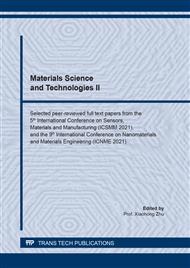[1]
Li Y, Wu Q, Kang M, et al. Boosting the photodynamic therapy efficiency by using stimuli-responsive and AIE-featured nanoparticles[J]. Biomaterials, 2019, 232:119749.
DOI: 10.1016/j.biomaterials.2019.119749
Google Scholar
[2]
Hu F, Yuan Y, D Mao, et al. Smart activatable and traceable dual-prodrug for image-guided combination photodynamic and chemo-therapy[J]. Biomaterials, 2017, 144:53-59.
DOI: 10.1016/j.biomaterials.2017.08.018
Google Scholar
[3]
X Yi, Hu J, Dai J, et al. Self-Guiding Polymeric Prodrug Micelles with Two Aggregation-Induced Emission Photosensitizers for Enhanced Chemo-Photodynamic Therapy[J]. ACS Nano, 2021, 15(3).
DOI: 10.1021/acsnano.0c09407.s001
Google Scholar
[4]
AIE-active theranostic system: selective staining and killing of cancer cells[J]. Chemical Science, (2017).
Google Scholar
[5]
Wu W, D Mao, Xu S, et al. High-performance photosensitizers with aggregation-induced emission for image-guided photodynamic anticancer therapy[J]. Materials Horizons, 2017:10. 1039.C7MH00469A.
DOI: 10.1039/c7mh00469a
Google Scholar
[6]
Lx A, Sz A, Xiao L B, et al. Novel biocompatible AIEgen from natural resources: Palmatine and its bioimaging application - ScienceDirect[J]. Dyes and Pigments, 2020, 184.
DOI: 10.1016/j.dyepig.2020.108860
Google Scholar
[7]
Chang C, Hsieh M C, Lin J C, et al. Selective photodynamic therapy based on aggregation-induced emission enhancement of fluorescent organic nanoparticles[J]. Biomaterials, 2012, 33(3):897-906.
DOI: 10.1016/j.biomaterials.2011.10.018
Google Scholar
[8]
Zhuang J, Yang H, Li Y, et al. Efficient photosensitizers with aggregation-induced emission characteristics for lysosome- and Gram-positive bacteria-targeted photodynamic therapy[J]. Chemical Communications, 2020, 56(17):2630-2633.
DOI: 10.1039/d0cc00394h
Google Scholar
[9]
Wang Y , Xu D , Gao H , et al. Mechanofluorochromic properties of aggregation-induced emission-active tetraphenylethene-containing cruciform luminophores[J]. Dyes & Pigments, 2018: S0143720817326207.
DOI: 10.1016/j.dyepig.2018.04.021
Google Scholar
[10]
Benov, Ludmil. Photodynamic therapy: current status and future directions. [J]. Med Princ Pract, 2015, 24(s1):14-28.
DOI: 10.1159/000362416
Google Scholar
[11]
Hu F, Yuan Y, D Mao, et al. Smart activatable and traceable dual-prodrug for image-guided combination photodynamic and chemo-therapy[J]. Biomaterials, 2017, 144:53-59.
DOI: 10.1016/j.biomaterials.2017.08.018
Google Scholar
[12]
Leung C, Wang Z, Zhao E, et al. A Lysosome-Targeting AIEgen for Autophagy Visualization[J]. Advanced Healthcare Materials, 2016, 5(4):427-431.
Google Scholar
[13]
Wang J, Zhang W, Wu T, et al. Photodynamic antitumor activity of aggregation-induced emission luminogens as chemosensitizers for paclitaxel by concurrent induction of apoptosis and autophagic cell death[J]. Materials Chemistry Frontiers.
DOI: 10.1039/d1qm00089f
Google Scholar
[14]
X Cai, Liu B. Aggregation-Induced Emission: Recent Advances in Materials and Biomedical Applications[J]. Angewandte Chemie International Edition, (2020).
Google Scholar
[15]
Guillermo Moreno-Alcantara, Alibrandi A, Cola L D. Aggregation-Induced Emission in Electrochemiluminescence: Advances and Perspectives[J]. Topics in Current Chemistry, 2021, 379(4).
DOI: 10.1007/s41061-021-00343-9
Google Scholar
[16]
Dler E, Frster. Der Konzentrationsumschlag der Fluoreszenz des Pyrens[J]. Ztschrift für Physikalische Chemie, 1962, 31(1_4):274-277.
DOI: 10.1524/zpch.1962.34.1_4.132
Google Scholar
[17]
Meng G, Tang B Z. Fluorescent Sensors Based on Aggregation-Induced Emission: Recent Advances and Perspectives[J]. ACS Sensors, 2017, 2(10).
DOI: 10.1021/acssensors.7b00551
Google Scholar
[18]
Terai T, Nagano T. Small-molecule fluorophores and fluorescent probes for bioimaging[J]. Pflügers Archiv - European Journal of Physiology, 2013, 465(3):347-359.
DOI: 10.1007/s00424-013-1234-z
Google Scholar
[19]
Sample V, Newman R H, Zhang J. The structure and function of fluorescent proteins[J]. Chemical Society Reviews, 2009, 38(10):2852-2864.
Google Scholar
[20]
Kwok R, Leung C, Lam J, et al. Biosensing by luminogens with aggregation-induced emission characteristics[J]. Chemical Society Reviews, 2015, 44.
DOI: 10.1039/c4cs00325j
Google Scholar
[21]
Zhu C, Kwok R, Lam J, et al. Aggregation-Induced Emission: A Trailblazing Journey to the Field of Biomedicine[J]. Acs Applied Bio Materials, (2018).
DOI: 10.1021/acsabm.8b00600
Google Scholar
[22]
Feng G, Liu B. Multifunctional AIEgens for Future Theranostics[J]. Small, 2016, 12(47).
Google Scholar
[23]
Miaomiao, Zhijun, Wenhan, et al. Good Steel Used in the Blade: Well-Tailored Type-l Photosensitizers with Aggregation-induced Emission Characteristics for Precise Nuclear Targeting Photodynamic Therapy. [J]. Wiley Online Library, (2021).
DOI: 10.1002/advs.202100524
Google Scholar


